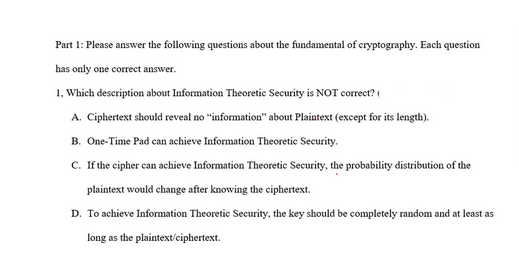Part 1: Please answer the following questions about the fundamental of cryptography. Each question has only one correct answer. 1. Which description about Information Theoretic Security is NOT correct? A. Ciphertext should reveal no "information about Plaintext (except for its length). B. One-Time Pad can achieve Information Theoretic Security. C. If the cipher can achieve Information Theoretic Security, the probability distribution of the plaintext would change after knowing the ciphertext. D. To achieve Information Theoretic Security, the key should be completely random and at least as long as the plaintext/ciphertext.
Part 1: Please answer the following questions about the fundamental of cryptography. Each question has only one correct answer. 1. Which description about Information Theoretic Security is NOT correct? A. Ciphertext should reveal no "information about Plaintext (except for its length). B. One-Time Pad can achieve Information Theoretic Security. C. If the cipher can achieve Information Theoretic Security, the probability distribution of the plaintext would change after knowing the ciphertext. D. To achieve Information Theoretic Security, the key should be completely random and at least as long as the plaintext/ciphertext.
Computer Networking: A Top-Down Approach (7th Edition)
7th Edition
ISBN:9780133594140
Author:James Kurose, Keith Ross
Publisher:James Kurose, Keith Ross
Chapter1: Computer Networks And The Internet
Section: Chapter Questions
Problem R1RQ: What is the difference between a host and an end system? List several different types of end...
Related questions
Question

Transcribed Image Text:Part 1: Please answer the following questions about the fundamental of cryptography. Each question
has only one correct answer.
1, Which description about Information Theoretic Security is NOT correct?
A. Ciphertext should reveal no "information" about Plaintext (except for its length).
B. One-Time Pad can achieve Information Theoretic Security.
C. If the cipher can achieve Information Theoretic Security, the probability distribution of the
plaintext would change after knowing the ciphertext.
D. To achieve Information Theoretic Security, the key should be completely random and at least as
long as the plaintext/ciphertext.
Expert Solution
This question has been solved!
Explore an expertly crafted, step-by-step solution for a thorough understanding of key concepts.
Step by step
Solved in 2 steps

Recommended textbooks for you

Computer Networking: A Top-Down Approach (7th Edi…
Computer Engineering
ISBN:
9780133594140
Author:
James Kurose, Keith Ross
Publisher:
PEARSON

Computer Organization and Design MIPS Edition, Fi…
Computer Engineering
ISBN:
9780124077263
Author:
David A. Patterson, John L. Hennessy
Publisher:
Elsevier Science

Network+ Guide to Networks (MindTap Course List)
Computer Engineering
ISBN:
9781337569330
Author:
Jill West, Tamara Dean, Jean Andrews
Publisher:
Cengage Learning

Computer Networking: A Top-Down Approach (7th Edi…
Computer Engineering
ISBN:
9780133594140
Author:
James Kurose, Keith Ross
Publisher:
PEARSON

Computer Organization and Design MIPS Edition, Fi…
Computer Engineering
ISBN:
9780124077263
Author:
David A. Patterson, John L. Hennessy
Publisher:
Elsevier Science

Network+ Guide to Networks (MindTap Course List)
Computer Engineering
ISBN:
9781337569330
Author:
Jill West, Tamara Dean, Jean Andrews
Publisher:
Cengage Learning

Concepts of Database Management
Computer Engineering
ISBN:
9781337093422
Author:
Joy L. Starks, Philip J. Pratt, Mary Z. Last
Publisher:
Cengage Learning

Prelude to Programming
Computer Engineering
ISBN:
9780133750423
Author:
VENIT, Stewart
Publisher:
Pearson Education

Sc Business Data Communications and Networking, T…
Computer Engineering
ISBN:
9781119368830
Author:
FITZGERALD
Publisher:
WILEY